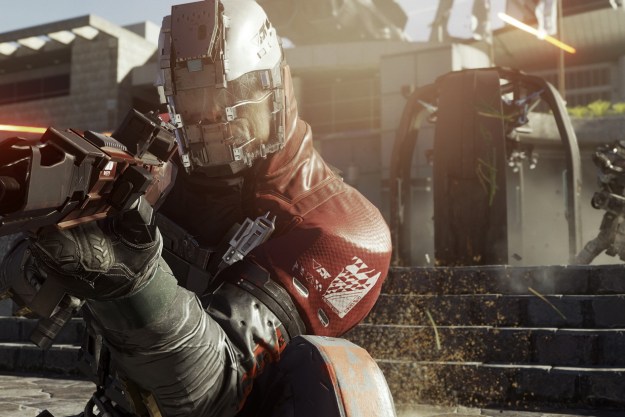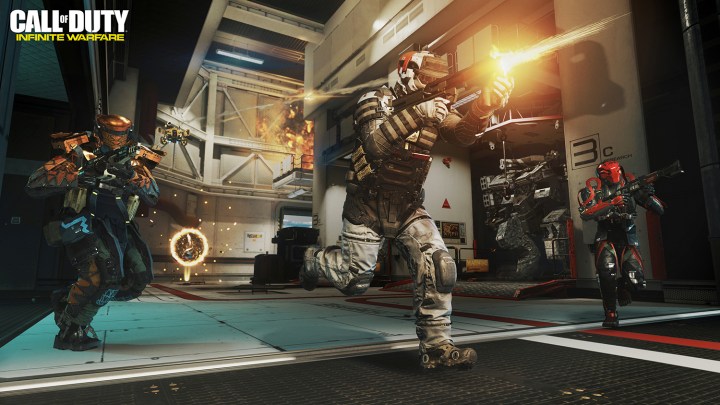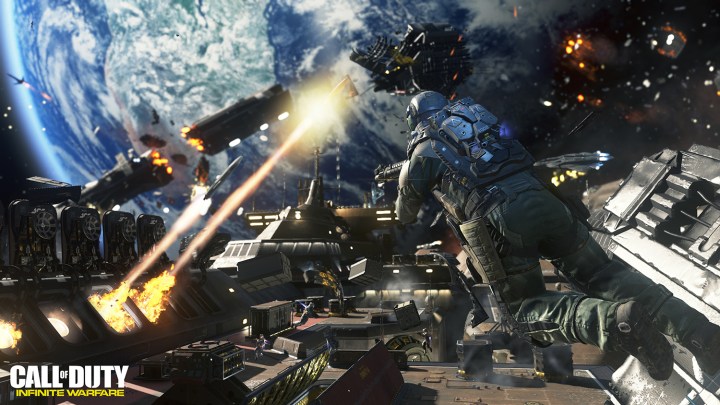
“'Call of Duty: Infinite Warfare' delivers one of the best campaign stories in the series history.”
- Campaign packed with dogfights, zero-g fighting
- One of the most interesting stories in the series
- Side missions add variety, including stealth
- Jumpy gameplay and tactical assault don’t mix
- Constant shot-in-the-back moments in multiplayer
One has to wonder how much of Call of Duty: Infinite Warfare was left up to the lead studio behind it, the franchise’s founding developer, Infinity Ward.
To release a new Call of Duty every year, as publisher Activision has for more than a decade, a rotating stable of developers take turns shaping each entry in the series. That has to led sub-franchises within the series, such as the Infinity Ward’s “Modern Warfare” series, and Treyarch’s “Black Ops” games. Though Infinity Ward created the franchise, the developer has not been its creative leader in Call of Duty‘s latest cycles. And at this point, there have been successful Call of Duty games produced in “off years” by other lead studios that overshadow the “main” Infinity Ward entries. Meanwhile, Infinity Ward’s last title, Call of Duty: Ghosts, was panned by many fans.
With that in mind, you can understand why Infinite Warfare feels more akin to its immediate predecessors than Infinity Ward’s own games. Its multiplayer and much of its gameplay are based on the faster, jumpier Call of Duty: Advanced Warfare, Sledgehammer Games’ first foray into the series as lead studio, and it includes a “Zombies” mode, a chunk of the formula that originated with Call of Duty: Black Ops developer Treyarch.
Despite gathering pieces from successful Call of Duty titles, a lot of Infinite Warfare just feels like it doesn’t quite work. Even with a new interstellar setting that makes way for what may be the strongest story the series has ever told, Infinite Warfare often tries to combine disparate elements that don’t really mesh. It wants to be a fast, vertical shooter, but also considered and tactical; the juxtaposition of those two styles creates chaos and, often, frustration.
Too fast, but too slow
For years, Call of Duty’s has focused on creating a “military shooter,” encouraging players to move through its levels and maps carefully, taking cover and watching for opportunities. This was always a function of its quick “time-to-kill” — the speed with which you kill another player when shooting at them, or they kill you. To make Call of Duty feel, to some degree, more realistic than other shooters, its time to kill, or TTK, is pretty short. You die quickly, which rewards playing tactically and punishes mistakes severely.
In recent entries, Call of Duty has been angling to get players off the ground and moving around. Advanced Warfare and Call of Duty: Black Ops 3 added wall-running, double-jumping and speedy sliding. These mechanics encourage you to get out of cover, moving fast and flanking enemies. Despite the shift, the TTK has always stayed high.
While the emphasis on speedier movement and character roles worked pretty well last year in Black Ops 3, it feels out of sync in Infinite Warfare. Multiplayer here is an exercise in getting dropped by someone rounding a corner behind you, or sprinting to catch up to a firefight only to get annihilated immediately by whoever is waiting in the room. More often than not, you’re dead before you know someone had you in their sights. It goes both ways, of course, but it seems that at almost all times, actually using the bag of tricks Infinite Warfare gives to players — the running on walls, the zipping through the air — puts you in jeopardy, instead of making you formidable.
Space, as it turns out, feels like a great addition to Call of Duty.
Map design is a factor in this equation, too. Infinite Warfare’s maps generally feel like mazes of interconnecting hallways and rooms that loop back on one another in confusing ways. It’s incredibly common to get shot in the back by someone you never could have accounted for and had no chance of defeating.
That may simply sound like a standard Call of Duty map, and it basically is, which is exactly why these maps need to be perfectly tuned. Black Ops 3’s maps, for example, also featured lots pathways and corridors. But Treyarch used them to drive engagements toward central locations, which encouraged teams to work together and limited the amount to which a random enemy might pop up behind you and grease everybody.
And then there are the guns. Infinite Warfare is littered with insane, fast-firing future weapons. These guns were not all created equal, though. Several of the weapons feel basically worthless in multiplayer — you need the quickest ones, the ones that dump bullets into bodies at blinding speed; bring the wrong weapon to a one-on-one quickdraw and you lose. And you lose. And you lose.
Bring it all together, and Infinite Warfare’s multiplayer problem is its chaos. Every match feels like a constant barrage of players flowing in from all directions, blasting each other in a constant deluge of zippy deaths. And unlike its fast, spacey competitor, Titanfall 2, Infinite Warfare’s chaos doesn’t give players the tools to create amazing moments. It serves to bring you down a peg, reminding you that for every sick double-kill there’s somebody rounding the corner who will suck the wind out of your sails.
Infinite Warfare has all the trappings of latter-day Call of Duty gameplay but feels like it has utilized them incorrectly, smashing the puzzle pieces together in a ways that don’t quite fit. And the result is a version of CoD multiplayer that’s just frustrating.
Answering the call
Surprisingly, it’s Infinite Warfare’s single-player campaign, rather than its multiplayer, that really stands out. More surprising still, it’s the game’s story that elevates it to new heights.
Set in a distant future, where the solar system has been colonized, Infinite Warfare follows Lt. Nick Reyes and the crew of the ship Retribution after Earth is ambushed by forces of the Settlement Defense Front, a military separatist group based on Mars that literally hates freedom. The SDF is straight evil, and its attack ravages Earth’s fleet — leaving Reyes to take command of the Retribution and go on the offensive, executing hit-and-run attacks all over the system.

It sounds a whole lot like the 2004 TV series Battlestar Galactica, but free of pesky questions about the motivations of the enemy or the politics of war. Focusing tightly on the efforts of the Retribution crew, the game paints the picture of a small but empathetic group of characters, which pulls you into an effective, exciting story about a commander coming to grips with the fact that he can’t save all of his people, and his hesitation might cost the war, Earth, and everyone on his ship.
Infinite Warfare is full of great characters, from its hard-headed protagonist Commander Reyes and his second-in-command, the fiery Lt. Salter, to the wisecracking robot companion Ethan and the incredulous Sgt. Omar. By the end of the game, Infinite Warfare invests enough in its characters’ humanity to make them endearing. You care about their fates, giving weight to an interesting, if ultimately generic, war story.
The primary story arc is buttressed by a series of side missions that inject a lot of gameplay variety into the Infinite Warfare campaign. You’ll fly your Jackal, a fighter jet-like space ship, in a series of dogfights, battle enemies in zero-gravity, and even sneak around in disguise to assassinate high-ranking enemy officers. There are a surprisingly wide array of scenarios in these missions, each of which adds strong mechanics that are simultaneously challenging and easy to pick up. Space, as it turns out, feels like a great addition to Call of Duty.
The campaign, however, still suffers from the internal conflicts that hold back the game’s multiplayer. It can be hard to spot enemies in any given level — especially those with dark corridors — and harder still to take them out. It feels as though Infinity Ward has greatly increased the penalty for taking a hit: Your vision shakes so much that it becomes difficult to identify what direction the bullets are coming from, and where you should escape to. All the boosting and wall-running abilities of previous games feel wasted, because spending a significant amount of time out of cover will always be detrimental.
Despite those mechanical flaws, Infinite Warfare has a lot of great stuff going for it in its campaign. The story, as well as ship-to-ship and zero-g combat, are all great additions to the Call of Duty franchise as a whole. It’s worth powering through its weakest gameplay moments to experience the story and a series of phenomenal set-piece action sequences.
And Zombies, in a 1980s movie space theme park, apparently
Finally, there’s Infinite Warfare’s take on “Zombies,” the self-contained co-op mode popularized by the Treyarch’s Call of Duty: Black Ops sub-franchise. This year’s version, “Zombies in Spaceland,” is as goofy as ever. Rather than bringing the undead to space, players control a squad of 1980s stereotype characters — actors, in fact, who find themselves sucked into a bizarro horror movie — fighting their way through an outer space theme park filled with the wave after wave of undead creatures, including exploding clowns.
If you’ve played Zombies in past Call of Duty games, you know exactly what to expect from “Zombies in Spaceland.” Infinity Ward hasn’t reinvented Treyarch’s wheel here, unlike past attempts at a similar cooperative mode like “Spec Ops” in the later Modern Warfare games or the alien-fighting “Extinction” mode in Ghosts. This is straight-up Zombies as players have come to know it.
Zombies has become a pretty tried-and-true component of Call of Duty thanks to Treyarch’s four games, and “Zombies in Spaceland” is about as good as any of the past Zombies offerings. Free from having to invent the mode from scratch, Infinity Ward has focused on making “Spaceland” as cool as possible, adding new mechanics and little quality of life improvements. There are arcade games to play, which pay out tickets you can use to buy new weapons. There’s also a new money sharing capability that lets teams of players pool resources and better coordinate their progress through the mode. None of these changes rewrite how Zombies works, but Infinity Ward’s changes all improve the formula. Fans will be happy to see the gameplay refreshed, and new players may find the barrier of entry to Zombies a little lower than in past games — although it’s still full of mechanics that have to be played, experienced and toyed with to fully understand.
Our Take
Infinity Ward has done some phenomenal work in Call of Duty: Infinite Warfare, especially in its campaign. The game itself, however, is a mixed bag of solid Call of Duty elements remixed in a way that doesn’t always work. Sometimes, it’s exciting, fresh, explosive, and gripping. Other times, it’s just not very much fun to play.
What’s the alternative?
With an extensive field of great shooters this year, there are many games we’d recommend playing before checking out Call of Duty: Infinite Warfare. Titanfall 2, a competitive first-person shooter with a sci-fi setting, is the best direct analogue. Titanfall 2 does a better job of making many of the ideas found in Infinite Warfare fun to play, even as CoD surpasses it in the storytelling department.
You might also look at Battlefield 1 for a more grounded, military feel, or Overwatch for something exclusively focused on team-based multiplayer gameplay.
How long will it last?
Infinite Warfare’s single-player campaign is fairly long if you opt to play its optional side missions, but like other games in the series, it won’t take longer than five or six hours to complete. With a multiplayer mode full of weapons, unlockable character classes, perks and scorestreaks, Infinite Warfare’s multiplayer can keep you busy for a very, very long time. Based on past Call of Duty games, Infinity Ward will likely add new multiplayer maps until next year’s game. Plus, there’s “Zombies in Spaceland,” which is a whole separate experience and best enjoyed with three friends. There’s a lot in the package.
Should you buy it?
Don’t buy ‘Call of Duty: Infinite Warfare’ for the multiplayer; there are other shooters this year that do it better. But for single-player spectacle and intensity, Infinite Warfare is a winner.
Call of Duty: Infinite Warfare was reviewed on PlayStation 4 using a copy provided by Activision.






